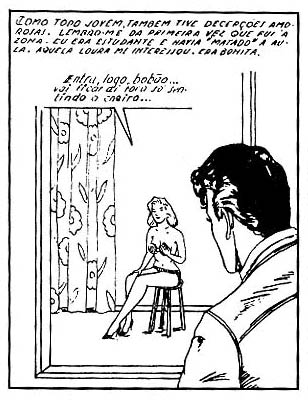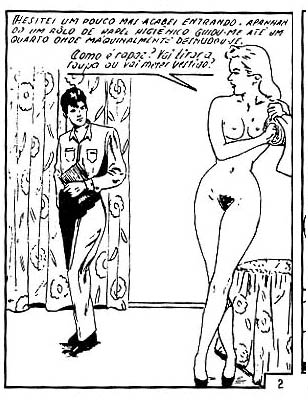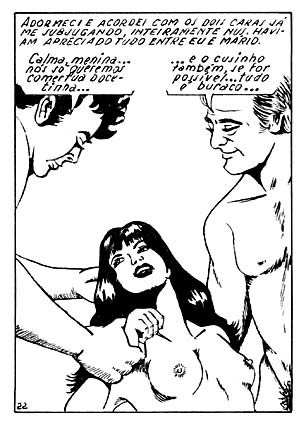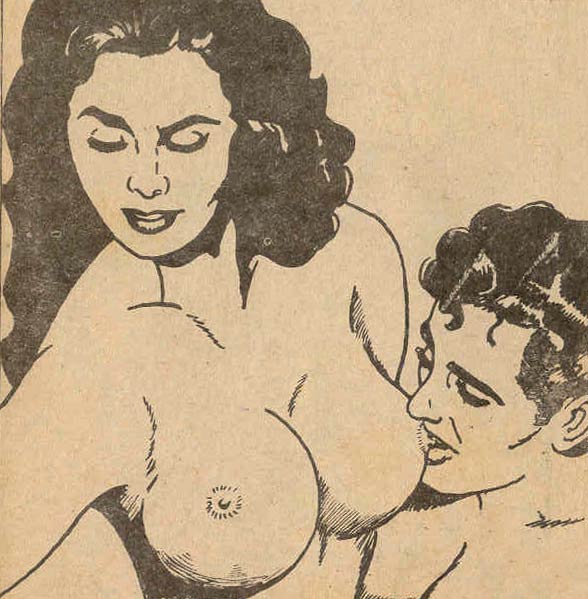Covers for erotic comic books, 'Filme de Amor' and 'Suzette' by Carlos Zéfiro.
Carlos Zéfiro was a Brazilian artist of pornographic comics. His small publications, drawn very crudely, circulated clandestinely during the 1950s and 1960s. Interest in his work declined in the 1970s, when magazines with photos of explicit sex were sold freely on Brazilian newsstands. It wasn't until shortly before his death in 1992 that Zefiros' identity was revealed. It turned out that he was not a professional artist at all, but a government employee and notable songwriter called Alcides Aguiar Caminha. Nowadays, his work is treasured out of nostalgia, and original editions of his booklets fetch high prices at auctions.
Personal life
Alcides de Aguiar Caminha Filho was born in 1921 in São Cristóvão, a neighborhood in the city of Rio de Janeiro. Together with his family, he spent most of his professional life in Rio de Janeiro, although in the 1970s they also resided in Brasília for a few years. Caminha was a public servant, who mostly worked at the Department of Immigration in Rio de Janeiro as a specialist in fingerprint identification. In his spare time, he undertook other activities. One was writing lyrics for samba songs, which were performed by artists such as Nelson Cavaquinho and Roberto Silva. Among his best-known compositions were 'Notícia' (1950s) and 'A Flor e o Espinho' (1973). He kept his other work more under the radar: writing and drawing pornographic mini-comics under the alias Carlos Zéfiro.
'A Desforra'.
Catechisms
It is estimated that Zéfiro drew over 800 booklets, which were ironically called "catechisms". Because of their clandestine nature, there are no official records of their production. They were presumably made from the late 1950s until the late 1970s, and sold under the counter at newsstands. Copies also circulated at places where men gathered, such as barbershops. Zéfiro's comic books mostly had 32 pages, and a format of 10x14 cm. The "catechisms" were handmade with the help of close friends, who printed and distributed the books. Several even made it as far as Uruguay and Argentina. One could state that several young men in South America discovered sexuality through Zéfiro's work during the years of Brazil's military regime and its censorship. His stories dealt with all sorts of pornographic subjects. In a way, they can be compared to the Tijuana Bibles by Wesley Morse and a host of anonymous creators from the United States. The main difference is that the Tijuana Bibles depicted popular comic characters in sexual activities, and Zéfiro's catechisms didn't (with the exception of a 'Tarzan' parody by Zéfiro). The Bibles were also more cartoony, while the catechisms were realistically drawn. Zéfiro was not a trained artist, but got his main inspiration from the Mexican romance comics published by Editormex and Swedish erotic photo-comics. The first pages of a story usually started with the protagonist meeting a girl. The seduction segment lasted until page 15, and the remaining pages explicitly exposed the results of these efforts. Zéfiro was also not shy of recycling; one can find the same erotic situation in different publications.
The pose in the image on the right was inspired by Auguste Rodin's sculpture 'Le Baiser' ('The Kiss').
Anonymity
It is no surprise that the artist used a pseudonym, as distributing such "scandalous" content was illegal in Brazil during the 1950s and 1960s. Even if he didn't end up in jail, he would certainly have lost his government job. Zéfiro's carefully guarded anonymity saved him on at least one occasion. In 1970 his main editor, Hélio Brandão, was arrested and put in jail for three days. The editor, who ran his own second hand book shop, had published over 2,000 pornographic comic books, which were not only drawn by Zéfiro, but also by Eduardo Barbosa, a certain "Chang" and several anonymous creators. Later that decade the rules for erotic content were loosened, and porn magazines were sold more freely on newsstands. The downside was that interest in Zéfiro's comics started to decline, first of all because it lost its excitement and secondly because there were now actually pornographic photos and films instantly available. By the late 1970s Zéfiro therefore mostly retired from his endeavors.
Final years, death and legacy
But his legend remained intact. By then, the wildest stories had been going around regarding the mysterious artist. Some said he was a former seminarian, which would explain the "catechisms" label for his booklets. It wasn't until a few months before his death that the November 1991 issue of the Brazilian Playboy magazine revealed that Zéfiro was in fact Alcides Caminha. Caminha had decided to "surrender" after his colleague Eduardo Barbosa had stated that he was the one behind the Zéfiro pen name. By then, the "catechisms" were already regarded as items of nostalgia, and even praised for their historical value. Already during his lifetime, Carlos Zéfiro was the subject of such compilation books as 'O Quadrinho Erótico de Carlos Zéfiro' (1984) by journalist and cartoonist Otacílio D'Assunção and 'A Arte Sacana de Carlos Zéfiro' (1983) by Joaquim Marinho. Marinho later also compiled 'Os Alunos Sacanas de Carlos Zéfiro' (2008). Caminha was awarded the Troféu HQ Mix at the first Biennial International Comics Festival in Rio de Janeiro in 1992. He however passed away from a stroke shortly afterwards, on 5 July 1992.
Recognition continued in the years following his death. Brazilian journalists Lucas Frasão and Marcio Orsolini have been working on a biography about the artist's life since 2007. Facsimile reprints of his comic books have appeared, as did an overview book called 'O Deus da Sacanagem - A Vida e o Tempo de Carlos Zéfiro' (2018) with comics historial Gonçalo Junior. The singer Marisa Monte used Zéfiro art on the cover of her album 'Barulhinho Bom - Uma Viagem Musical' (1996). The artist is also still remembered for his musical work. Since 1999, his neighborhood Anchieta has its own cultural center named Lona Cultura Carlos Zéfiro, where musical shows and workshops were organized.
The Brazilian comic artist Sebastião Seabra used the pen name Sebastião Zéfiro for his erotic art, in honor of Carlos Zéfiro.
Erotic panel by Carlos Zéfiro.









